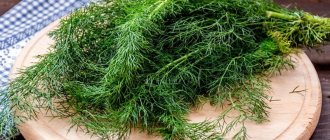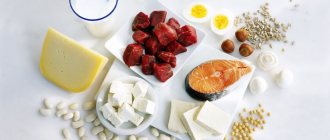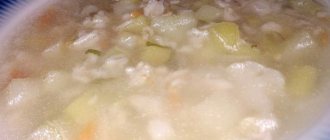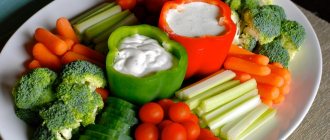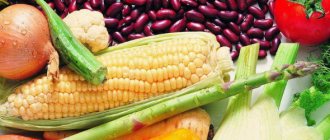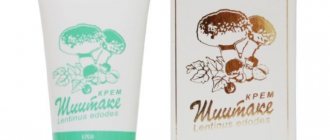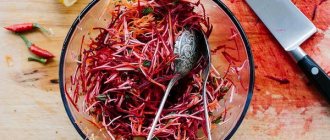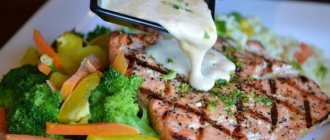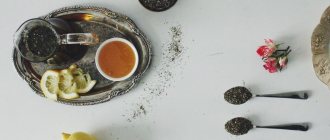Add more aromatic herbs to your plate, the taste of any dish will improve, and the body will benefit completely. Fresh herbs on the table are a wonderful natural way to rejuvenate and increase vitality. It should definitely be included in the daily menu for anyone who wants to have a blooming and healthy appearance.
Greens help the functioning of the stomach and intestines, supply the body with vitamins and minerals. Any greenery is useful, you just need to find your bunch.
The first May greens are very healthy, rich in a huge amount of vitamins, but despite this there are contraindications, for example, dill cannot be taken during pregnancy, so sometimes greens can do more harm than good, be sure to take this into account.
Description and characteristics of two plants
Dill and parsley are common spices that are used both fresh and dry. Both herbaceous plants are short-lived, belong to the Apiaceae family, are widely cultivated in gardens and have beneficial properties. The branched stems of curly parsley are similar to cilantro, which is why they are often confused.
The plant does not live for more than 2 years, is characterized by a thick spindle-shaped rhizome and glossy cut foliage of a dark green color, develops to a maximum height of 30 cm. It blooms in mid-summer with greenish-yellow inflorescences. Dill single shoots are distinguished by their curved and feathery foliage. As she ages, she becomes lighter. The lower petioles are wider than the upper ones. At the peak of the growing season, the crop can reach 1.5 m in height, but more often it develops within half a meter.
Small umbrella inflorescences of pale yellow color appear at the end of June. By September, broadly elliptical dark brown grains ripen from them. The peculiarity of parsley and dill is their rich chemical composition, which at the same time has many similarities and differences. The benefits of each herb are shown in the table below.
| Comparative characteristics of the compositions of parsley and dill (in 100 g) | ||
| Constituent substance | Quantity in dill | Amount in parsley |
| Water | 85.97 g | 87.71 g |
| Carbohydrates | 4.92 g | 3.03 g |
| Alimentary fiber | 2.1 g | 3.3 g |
| Fats | 1.12 g | 0.79 g |
| Squirrels | 3.46 g | 2.97 g |
| Ash | 2.45 g | 2.2 g |
| Retinol (A) | 386 mcg | 421 mcg |
| Tocopherol (E) | — | 0.53 mg |
| Phylloquinone (K) | — | 1640 mcg |
| Ascorbic acid (C) | 85 mg | 133 mg |
| Thiamine (B1) | 0.06 mg | 0.09 mg |
| Riboflavin (B2) | 0.3 mg | 0.1 mg |
| Pantothenic acid (B5) | 0.4 mg | 0.4 mg |
| Pyridoxine (B6) | 0.19 mg | 0.09 mg |
| Folate (B9) | 150 mg | 152 mg |
| Niacin (RR) | 1.57 mg | 1.31 mg |
| Choline (B4) | — | 12.8 mg |
| Potassium | 738 mg | 554 mg |
| Calcium | 208 mg | 138 mg |
| Magnesium | 55 mg | 55 mg |
| Sodium | 61 mg | 56 mg |
| Phosphorus | 66 mg | 58 mg |
| Iron | 6.59 mg | 6.2 mg |
| Manganese | 1.26 mg | 0.16 mg |
| Copper | 0.15 mg | 0.15 mg |
| Selenium | — | 0.1 mcg |
| Zinc | 0.91 mg | 1.07 mg |
Basics of agricultural technology
Garden dill is an unpretentious plant that is grown almost everywhere.
The agricultural technology of its cultivation is simple, but there are features that must be taken into account in order to obtain healthy, aromatic greens :
- To grow dill, select an area with light, loose soil rich in organic matter. The plant does not tolerate alkaline soils.
- For full growth and development, you need a sufficient amount of light, otherwise the leaves will lighten and the stem will stretch and droop.
- The best predecessors for dill are legumes, cabbage, and cucumbers. Areas where crops from the umbrella family (parsley, carrots, cumin, etc.) were grown are absolutely unsuitable.
- Organic matter is applied to predecessor crops; only mineral fertilizers are used for dill - per 1 m² 20 g of nitrogen and potassium and 30 g of phosphorus.
- Seeds are sown in open ground in mid-late April. Germination temperature is +4°C; covering material is used to speed up the process. The distance between the rows when sowing greens is 15-20 cm, the seeding depth is 2-2.5 cm. It is possible to grow dill using seedlings.
- To obtain early greenery, it is possible to sow dill before winter.
- Dill seeds take a long time to germinate: if you sow dry seeds, seedlings will appear only after 2-3 weeks. Therefore, before sowing, it is better to soak the seeds for 2-3 days in warm water, changing it several times a day.
- When fighting diseases (for example, powdery mildew), the use of pesticides is not recommended, since the leaves are eaten. Use “Fitosporin” or 5% tincture of iodine - 40-50 drops per 10 liters of water with an interval of 2-3 treatments every 5-7 days.
- In order to have young greens throughout the season, dill is sown at several times with an interval of 10-15 days, starting in mid-late April.
- Dill needs regular watering, loosening and weeding.
- Greens are edible 20-30 days after sowing with a stem height of about 15 cm.
- Dill reproduces well by self-sowing. To do this, simply leave a few plants with umbrellas, and in the fall, further loosen the soil so that the seeds germinate better.
In addition to growing in the garden, dill can also be grown at home - on the windowsill.
Reference! When planted together with dill, the taste of peas, onions, beets, and white cabbage improves.
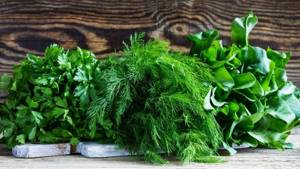
What are the benefits of parsley and dill?

The simplest dish will be transformed before your eyes if you add fresh herbs to it. What curly parsley and aromatic dill are rich and useful for is the abundance of vitamins and microelements, thanks to which they have a number of healing characteristics.
The main vitamins of parsley and dill
Parsley and dill are a source of ascorbic acid: 100 g (large bunch) can meet the body's daily requirement (167 and 83% of the daily dose, respectively). In terms of micronutrient content, greens are superior to cabbage (66.7%) and lemon (44.4%).
Vitamin C is considered one of the most powerful antioxidants that protects cells from free radicals. It protects the body from infections - bacterial, viral, parasitic, and promotes the production of hormones and neurotransmitters that are responsible for the emotional sphere. Vitamin C also has benefits:
- blood vessels, giving elasticity and strength;
- teeth and gums, keeping them healthy and strong;
- metabolic process, helping to avoid obesity;
- skin framework, promoting the formation of collagen fibers.

What vitamins and minerals does parsley contain?
Another nutrient you can get from spices is beta-carotene, or a precursor to vitamin A: parsley contains 106% of the daily value and dill contains 83%. Retinol is responsible for the health of the skin and its appendages (hair, nails), and is important for the strength of teeth and the body’s defenses. It also protects against colds, respiratory ailments, diseases of the digestive and genitourinary systems.
But in terms of vitamin reserves in parsley, the leader is phylloquinone - there are more than thirteen daily norms! Vitamin K, as it is also called, is necessary for the normal functioning of the kidneys, liver, and gall bladder.
When taken in sufficient quantities, it improves the absorption of calcium and its interaction with vitamin D, preventing the development of osteoporosis. Scientists have found that some proteins are synthesized only with the participation of phylloquinone. But dill contains much less of this component - only 13.4% of the daily requirement.
Parsley contains folic acid or vitamin B9. Deficiency of this element disrupts the formation of proteins and inhibits cell growth and division.
Calories and nutritional value
Comparative characteristics of the nutritional value of dill and parsley:
| The nutritional value | Dill | Parsley |
| calories | 43 kcal / 2% | 36 kcal / 1.5% |
| squirrels | 3.46 g / 6% | 2.97 g / 5% |
| fats | 1.12 g / 4.5% | 0.8 g / 3% |
| carbohydrates | 7 g / 5.5% | 6.33 g / 5% |
| cellulose | 2.10 g / 5.5% | 3.3 g / 8.5% |
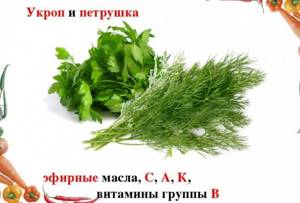
Health Benefits of Dill
One plant regularly used as a fresh herb is dill, which spread from the Mediterranean coast. Today it is often used in cooking, and it is added at the end of cooking.
It is enriched with many vitamins, there is carotene, folic, nicotinic acids, minerals, and trace elements. This composition allows:
- Normalize the gastrointestinal tract, lower blood pressure, strengthen the heart muscle.
- Eliminate manifestations of cystitis and kidney inflammation.
- Get rid of insomnia, get rid of migraines.
- Increase lactation.
Dill is a choleretic, diuretic substance. Its tincture is actively recommended for use in diseases of the urinary organs. For treatment you need to take 1 tbsp. l. dill seeds, pour 1 cup of hot water, leave for 15 minutes, consume 0.5 cups three times a day.
Dill helps in cosmetology, relieving eye fatigue; for this purpose, dill infusion is made, and thanks to the dill-parsley mask, you can get rid of freckles.
Parsley on your table
One of the most common green herbs is parsley; it contains a lot of vitamin C; its content is higher than that of citrus fruits. Leaf and root greens are used in cooking; leaf parsley has healing properties.
It contains essential oils, bioflavonoids, a lot of carotene, vitamins, folic acid, and inulin. Thanks to their presence it is possible to:
- Prevent the development of cancer formations.
- Protect the body from the effects of carcinogens.
- Restore acid-base balance.
- Normalize the menstrual cycle.
- Increase lactation.
- Cure the liver, organs of the digestive system.
- Restore hemoglobin levels.
- Get rid of eye problems.
- Prevent the development of vitamin deficiency.
Parsley juice
Using parsley juice, which has an antipyretic effect, you can eliminate swelling, traces of insect bites, whiten your skin, get rid of acne, and whiten your teeth. Due to the fact that the herb contains a lot of vitamin K, it helps those who have been taking antibiotics for a long time to recover.
Parsley in folk medicine
The seasoning has been used in this area for a long time and successfully. Below we will look at some useful tips and recipes.
Juice from parsley and beets in equal proportions helps with painful menstruation. If you take it regularly, you can achieve complete disappearance of pain.
To improve the condition of the skin, you can use a decoction of parsley (50 grams per half liter of boiling water). The decoction is prepared for 15 minutes over low heat, after which it is poured into molds and placed in the freezer. Use the resulting ice cubes to wipe your face and décolleté in the morning.
Juice from fresh parsley will help strengthen the immune system in the autumn-winter period. To prepare the product, you need to grind the greens in a blender and squeeze using a natural cloth. Take 1 teaspoon immediately after preparation, preferably in the morning.
A mask made from parsley and rich sour cream (yogurt) is used for dry skin. It especially helps in frosty weather, when wind and snow dry out your face. To prepare, you need to mix a tablespoon of crushed leaves with the same amount of fermented milk product. Apply for 15 minutes, rinse with cool water.
1, total, today
Source https://okeydoc.ru/zelen-petrushki-polza-i-vred/
Leave a comment 4,704
Treatment of diseases of the gallbladder and liver is carried out both with medication and with the help of folk remedies. Representatives of alternative medicine offer many recipes that can relieve inflammation from the gallbladder and normalize the functioning of the liver. These recipes contain various natural ingredients. In particular, it can be parsley and dill, which have a beneficial effect on the liver. But when using these plants as a remedy, it is worth considering not only their benefits, but also the harm and possible unpleasant consequences for the body.
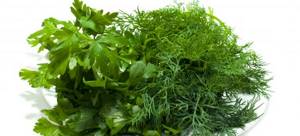
Traditional therapy uses greens as a cure for a number of diseases.
Benefits and medicinal properties
Dill seeds and greens, as well as parsley, are harvested for medicinal purposes. These plants have a beneficial effect on the human body.
Important! Due to the essential oils they contain, it is not recommended to store fresh parsley, dill and cilantro for more than 3 weeks. In this case, it is better to freeze the greens.
Parsley
The dry product does not differ from the fresh product in the composition of nutrients, but acquires a slight bitterness in taste. The amount of some vitamins and minerals in one bunch corresponds to a person’s daily needs.
- With regular consumption of parsley, the following results are obvious:
- the immune system is strengthened;
- the blood formula and its circulation improves;
- whitens the skin (when applied externally, the product is effective in the fight against age spots and freckles);
- waste and toxins are washed out of the body (has a diuretic effect);
- due to natural antibiotics (phytoncides), an antiviral and antibacterial effect occurs, which helps with acute respiratory diseases, sore throat and colds (the decoction is recommended for gargling);
- skin elasticity increases (lotions under the eyes are effective);
- the functioning of the visual organs improves.
Did you know? In the medicinal arsenal of the French queen Marie de' Medici, parsley was a particularly valuable remedy, as it was the main cure for depression and loss of strength.
Dill
The rich chemical composition of the plant is the main reason for its widespread popularity.
- Fragrant dill sprigs, as well as infusions and decoctions prepared from them, with regular consumption can:
- resist anemia;
- improve the body's defenses;
- restore damaged nail plates and hair;
- slightly improve vision;
- improve the functioning of the kidneys and excretory system;
- eliminate the causes of swelling;
- increase lactation;
- heal and relieve wounds;
- relieve inflammation (effective for insect bites, redness of the eyelids);
- normalize blood pressure;
- improve the condition of the skin (moisturize and tighten it);
- provoke expectoration of sputum;
- strengthen the nervous system, get rid of insomnia and depressive mood.
Possible harm
Sometimes it is better to limit the use of this spice . You should not consume dill in large quantities, as it has a vasodilating effect and lowers blood pressure. This can cause hypotension, deterioration of the condition, including fainting and temporary blurred vision.
Contraindications
It is undesirable to use dill:
- hypotensive patients;
- with poor blood clotting;
- pregnant women and during menstruation;
- in the presence of an allergic reaction.
Who benefits from herbs?
Both parsley and dill have a whole range of healing effects:
- prevent colds;
- eliminate hypovitaminosis;
- give health to the skin with acne and irritation.
Even the ancient Greek physician Hippocrates recommended taking dill to patients with digestive ailments due to the nitrogenous substances it contains.
Herbs are very useful if the diet is rich in fatty foods. Parsley helps you lose excess weight. To do this, decoctions are prepared from it or eaten raw. If you eat it with meat or fish, the portion eaten will be smaller, which will also affect your body weight. In addition, proteins with such spice are better absorbed.
For children
Both products should be in the diet of children due to the content of vitamins A and C. They help the baby fight viral infections, improve vision, and promote the normal development of bones and internal organs.
Pediatricians do not have a consensus on when to introduce foods into a child’s diet. Thus, American experts say that you can season food with boiled herbs as early as 6-8 months, and from 9 months - fresh. Domestic doctors do not recommend introducing children to herbs until they are 1–1.5 years old.
Women
For the fair half, the benefits of parsley lie in the seeds, a decoction of which helps to normalize the monthly cycle and reduce pain on menstrual periods. The root part increases breast milk production. Dill works similarly.
Decoctions and slurries from different parts are used in cosmetology. Such drugs help fight skin imperfections - acne, pigmentation, dandruff and seborrhea.
For men
For them, parsley improves potency, for which they eat both the juice and the above-ground part. The recommended daily dose is about 50 g. Greens eaten shortly before sexual intercourse have a positive effect on erection over the next three hours. This is due to the effect on the adrenal glands, which produce the male hormone testosterone.
Parsley contains apigenin, which suppresses estrogens and prevents effeminacy in a man's appearance - reduction of facial hair, fullness, softness. Dill works almost the same way, but its seeds are used for this.
Vitamins are not the main thing!
Many will be surprised to hear that spring greens are rich in beta-carotene, since we tend to think that this vitamin is found mainly in bright orange or red vegetables. Dill, onion or parsley cannot boast of a red color, but in terms of the amount of beta-carotene in one hundred grams they are not inferior to carrots.
Beta-carotene is absorbed by the body only in the presence of fat. That is why it is customary to put a spoonful of sour cream in a glass of carrot juice. But, since, as a rule, we add greens to ready-made dishes that contain fats, carotene from dill or parsley is absorbed without any problems.
By sprinkling salad or meat with herbs, you enrich the dish with vitamin C, which is found in green vegetables, although not as much as, for example, in sea buckthorn or black currant, but still a lot.
Other benefits of green vegetables include high levels of potassium, magnesium, manganese and vitamin K, which is responsible for blood clotting, promotes wound healing and aids calcium absorption.
However, it is worth remembering that we do not consume herbs in such quantities as to satisfy the body’s daily need for nutrients, so it is still not worth considering greens as a complete source of vitamins and microelements.
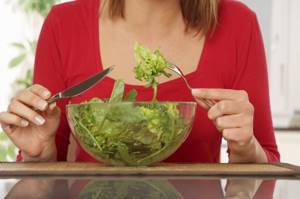
All representatives of the green family have a carminative effect. Therefore, they are useful for flatulence, bloating and intestinal problems. If you know firsthand about these diseases, feel free to season your dishes with herbs or prepare infusions. The recipe is simple: pour 1 teaspoon of chopped dill with 1 glass of boiling water, let it brew for 15–20 minutes in a sealed container and take 0.5 cups 2–3 times a day.
In addition, the herbs have a sap effect and stimulate the activity of the gallbladder and pancreas. Therefore, green onions or parsley will prevent heaviness in the stomach after a hearty meal and improve the well-being of people suffering from gastritis with low acidity.

How and where are these plants used?
Dill and parsley have found their use in pharmacology, cooking and folk medicine. Essential oils, extracts, lotions and medicines are made from dill. Also, with the help of this plant you can easily decorate or complement salads, sandwiches, meat, fish and almost any dish. Since ancient times, there have been many folk remedies using dill decoction; they drink it, breathe it, and use it as a lotion and ointment.
Parsley is mainly used in cooking. It has a specific smell and increases appetite. In addition, having a positive effect on many functions of the body, it strengthens the immune system. This plant is appreciated by all famous culinary schools, because dishes garnished with parsley look more aesthetically pleasing.
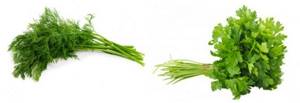
Dill and parsley
For diseases of the liver and biliary tract
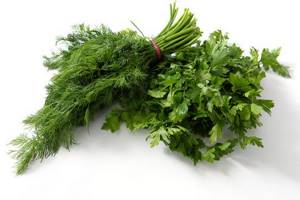
Proponents of traditional medicine offer many recipes that will help cope with liver dysfunction and biliary tract diseases. The most popular are:
- Parsley decoction. It is necessary to chop the parsley sprigs, take a tablespoon of this raw material and pour a glass of water. Then boil for a minute and let sit for half an hour. After this, you should strain the broth and drink 2 tbsp. l. before meals three times a day.
- Seed infusion. Pour 200 ml of cold water over a teaspoon of seeds, leave the liquid to infuse for 7-8 hours, then filter it and drink a tablespoon every 2 hours.
Dill is used in decoctions and infusions to stimulate the flow of bile.
- chop the dried herbs, take 3 large spoons and pour 200 ml of boiling water over them;
- bring to a boil for 10 minutes, then leave for 60 minutes;
- Strain the broth and add water until the volume reaches 200 ml;
- It is necessary to consume the remedy 100 ml in the morning, at lunch and in the evening 30 minutes before meals.
An effective healing remedy used among the people is an infusion of dill seeds. To prepare it, take a tablespoon of the main ingredient and pour 250 ml of boiling water over it, leave for 15-20 minutes to infuse, and after this time, cool and strain the infusion. You need to consume it in a large spoon every 2-3 hours, without connecting the time of administration with a meal.
Dill for the liver
Composition and benefits
Dill contains the following elements: iron, natural acids, vitamins, calcium, phosphorus, potassium and ascorbic acid. The drug has a diuretic, expectorant and analgesic effect on the human body. This remedy also helps improve vision and the digestive process.
Use for the liver
- A decoction promotes the flow of bile. To prepare it you should:
- Finely chop the greens.
- 3 tbsp. Pour boiled water (200 ml) into spoons of this raw material.
- Place on the fire and boil for 10 minutes, then leave to steep for 1 hour.
- The liquid is filtered and water is added to fill the volume to 200 ml.
- The medicine is taken 100 ml in the morning, lunch and in the evening 30 minutes before meals.
- Infusion based on dill seeds. To prepare this remedy:
- Take 1 tbsp. l. seeds and pour boiling water (200 ml).
- Leave for 15-20 minutes.
- The liquid is filtered and cooled.
- You should drink the infusion 1 tbsp. l. every 2-3 hours.
Return to contents
Contraindications and harm
Before starting therapy with dill-based medications, you should consult your doctor. If you use healing decoctions and infusions made with dill for a long time and in unlimited quantities, then a person may feel general weakness, drowsiness and decreased vision, nausea and indigestion.
People with blood pressure problems and a tendency to allergies are especially at risk. Dill is contraindicated for women during pregnancy.
Using parsley and dill
Doctors strongly recommend daily consumption of fresh greens, regardless of the season. In winter, with a deficiency of vitamins and an increased risk of viral diseases, its relevance increases. In addition, a bunch of dill and parsley can alleviate illness or prevent it. It’s not for nothing that our ancestors valued these plants primarily as medicine, and only then as seasoning.
Important! The freshness of the greens will remain longer if you lightly sprinkle the unwashed branches with water, place them in a plastic bag and put them in the refrigerator. It is advisable to first remove yellowed and blackened stems from the bunch.
Decorating dishes or green pharmacy?
Unfortunately, few people treat greens as an independent dish. We decorate salads with it, add it in tiny quantities to soups, but very rarely eat it just like that. And we don’t even think that from 100 g of banal parsley or dill you can get a daily dose of some vitamins, minerals and other substances that are very important for us.
Table: significant vitamins and minerals in parsley, dill and cilantro (per 100 g of fresh herbs)
| Compound | Dill | Parsley | Cilantro |
| The nutritional value | |||
| Squirrels | 2.5 g | 3.7 g | 2.13 g |
| Fats | 0.5 g | 0.4 g | 0.52 g |
| Carbohydrates | 6.3 g | 7.6 g | 0.87 g |
| Organic acids | 0.1 g | 0.1 g | — |
| Alimentary fiber | 2.8 g | 2.1 g | 2.8 g |
| Calorie content | 40 kcal | 49 kcal | 23 kcal |
| Vitamins | |||
| A | 750 mg | 950 mg | 337 mg |
| Beta carotene | 4.5 mg | 5.7 mg | 3.93 mg |
| Groups B | 13.75 mg | 13.24 mg | 13.81 mg |
| WITH | 100 mg | 150 mg | 27 mg |
| E | 1.7 mg | 1.8 mg | 2.5 mg |
| TO | 62.8 mg | 1640 mg | 310 mg |
| RR | 1.4 mg | 1.6 mg | 1.114 mg |
| Micro- and macroelements | |||
| Potassium | 335 mg | 800 mg | 521 mg |
| Calcium | 223 mg | 245 mg | 67 mg |
| Magnesium | 70 mg | 85 mg | 26 mg |
| Sodium | 43 mg | 34 mg | 46 mg |
| Phosphorus | 93 mg | 95 mg | 48 mg |
| Iron | 1.6 mg | 1.9 mg | 1.77 mg |
| Manganese | 1.264 mg | 0.16 mg | 0.426 mg |
| Copper | 146 mcg | 149 mcg | 225 mcg |
| Selenium | 2.7 mcg | 0.1 mcg | 0.9 mcg |
| Zinc | 0.91 mg | 1.07 mg | 0.5 mg |
| Other substances | |||
| Phytosterols | 5 mg | 5 mg | 5 mg |
| Omega-3 | 0.01 g | 0.456 g | — |
| Pectin | 0.7 g | 1.5 g | 1.7 g |
What are the benefits of garden greens:
- it contains natural antioxidants that keep us young;
- cleanses and restores normal blood composition;
- improves immune status;
- helps improve digestion, regulates the acidity of gastric juice, normalizes stool;
- has a beneficial effect on the functioning of the endocrine glands;
- reduces the risk of tumor formation and their degeneration into malignant forms.
What is healthier to eat: dill or parsley?
Fresh herbs have become a very popular commodity in Russian markets. It has gained popularity due to its beneficial properties and the ability to decorate various dishes. The most purchased herbs are parsley and dill. Both of these annual plants have many positive effects on the body and are excellent preventive agents against most diseases. To understand which is healthier, parsley or dill, you need to analyze their beneficial properties.
Decorating dishes or green pharmacy?
Unfortunately, few people treat greens as an independent dish. We decorate salads with it, add it in tiny quantities to soups, but very rarely eat it just like that. And we don’t even think that from 100 g of banal parsley or dill you can get a daily dose of some vitamins, minerals and other substances that are very important for us.
The most useful plant
Both plants are very beneficial for the human body, especially if consumed little by little. It would be better for teenagers to give preference to parsley, especially boys. It will promote normal hormonal development. It is also an indispensable remedy for smokers, it prevents the development of tumors in the lungs, and promotes the removal of tar. Middle-aged men will find salvation in this plant in the fight against classic male problems.
Dill is best suited for young children and older people. Children, because there is no allergy to dill, and they can easily tolerate this plant and all products based on it. Sensitive baby skin, if washed with solutions, will acquire a healthier shade and get rid of infant diaper rash, redness and rashes. For older people, dill protects against heart problems. Also suitable for people suffering from urolithiasis. A small amount of fragrant leaves will help anyone sleep.
Each plant has many advantages, and each has its own. The main thing is to approach the choice of greens wisely and not get carried away with them, then all the positive qualities will certainly affect your health.
Not for all
Despite all the usefulness of aromatic herbs, not everyone can prepare salads and cook green cabbage soup every day.
If you suffer from uraturia (a tendency to form urate stones in the kidneys) or suffer from gout, greens should be a delicacy for you. Moreover, it is safer to use dried parsley or dill rather than fresh.
Those who have elevated hemoglobin levels or thrombophlebitis should not overdo it with greens. Due to their high vitamin K content, onions, parsley or dill can trigger the formation of blood clots in such patients. Particular care should be taken with soups and salads if young nettle leaves are added. Hot herb is a strong hemostatic agent that works no worse than medications!
During the period of exacerbation of gastritis with high acidity, it is also necessary to temporarily part with green seasonings.
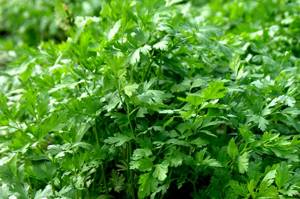
Recipes with parsley and dill
Parsley salad is very healthy, because parsley is rich in vitamins. It is advisable to add other greens, for example, dill and green onions. If you don't know how to cook a dish, read the recipes.
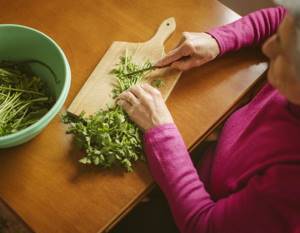
Parsley salad is prepared immediately before use.
Ingredients
Dill 50 grams
Vegetable oil 2 tbsp.
Lemon 1 piece
Green onion (feather) 100 grams
Parsley 200 grams
Salad with parsley, onion and dill
This dish combines several types of greens at once. This healthy vitamin salad goes well with potatoes and meat. The dish is also served with kebabs. Lemon juice is added as desired, since parsley already gives sourness. The lemon in this recipe neutralizes the smell and taste of the onions.
Preparation:
- Sort all the greens, wash and finely chop.
- Add salt and let sit for 10 minutes.
- Pour lemon juice over the salad.
- Season with vegetable oil.
Parsley for the liver
Composition and benefits
Parsley contains many useful microelements that have a beneficial effect on the human body. It is used in folk medicine to treat many diseases. Parsley is also used to strengthen hair and as a sedative during periods of depression and psychological disorders. This plant contains the following elements;
- vitamins;
- zinc, iron and calcium;
- essential oils;
- lithium and phosphorus;
- inulin;
- cellulose;
- fructose;
- phosphorus.
Return to contents
Folk recipes
Parsley has a positive effect on the liver and bile ducts. Medicines based on it, when used in complex therapy, will help improve the functioning of the organ and improve its condition. Traditional medicine offers the following parsley-based recipes:
- It can be used either raw or prepared as a decoction.
Decoction. To prepare you will need:
- Finely chop the branches of the plant.
- 1 tbsp. pour a spoonful of raw materials into 1 glass of water.
- Boil for 1 minute, then let it brew.
- Strain the broth.
- Take 2 tbsp. l. before eating 3 times for 24 hours.
- Infusion:
- 1 tsp. Pour the plant seeds with cold water (200 ml).
- Leave the liquid for 7-8 hours.
- Clean by filtration.
- Use every 2 hours.
Return to contents
Harm and contraindications
Parsley is often harmless to the human body. The plant must be grown at home. If growth stimulating chemicals were used, this can lead to negative consequences in the form of poisoning and general weakness. The plant is contraindicated for nephritis, acute cystitis and if there is a tendency to develop skin allergies
Fresh herbs can transform every dish, giving it a specific aroma and visually decorating it, so many housewives add chopped dill, parsley and green onions to every bowl. This ingredient is not just tasty, but also healthy, as it is a valuable source of vitamins and microelements. What is the peculiarity of these plants, how to use them for treatment and culinary preparations, how much and to whom they can be consumed - find out more about this from the article.
Who can't have greens?
A universal contraindication for all plants is individual intolerance to the product.
Parsley contains a substance called myristicin, which causes hallucinations, convulsions, and loss of balance. The plant is not recommended for oxaluria (a form of kidney stones), nephritis (inflammation of the kidneys), as it causes the movement of stones.
Since parsley is rich in vitamin K, which is responsible for blood clotting, it should be included with caution in the diet of people with diseases of the cardiovascular system, as well as those taking anticoagulants (drugs that thin the blood), since phylloquinone blocks their action.
Dill, unlike parsley, reduces the thickness of the blood. Therefore, if you have bleeding or are prone to it, the herb should be used extremely moderately, although you should not give it up completely. The spice lowers blood pressure, which is a warning for hypotensive patients, otherwise they may experience deterioration in well-being, drowsiness and blurred vision.
Parsley and dill are not only available in summer. In winter, they also need to be included in your diet to avoid vitamin deficiency. And you can grow greens even in an apartment building in your own mini-garden, arranging it on the windowsill.
Possible contraindications for use
Like any medicine, parsley and dill have their side effects and contraindications. People who have been diagnosed with the formation of large kidney stones should treat these plants with caution. The fact is that the herbal medicine stimulates the flushing out of the body of accumulated salts and sand.
This can provoke the release of the formed calculus - as a result, emergency removal by surgery is very likely. Caution should also be exercised by those who suffer from cardiovascular diseases. It is strictly not recommended to use dill and parsley for people with low blood pressure - otherwise dizziness, weakness and loss of strength cannot be avoided.
This side effect is associated with the ability of plants to dilate blood vessels and reduce blood pressure. If you do not overdo it with portions, then both plants in any form will not harm, but on the contrary, they will saturate your body with nutritional components. Therefore, do not neglect this seasoning and make sure that it does not disappear from the table at any time of the year.
